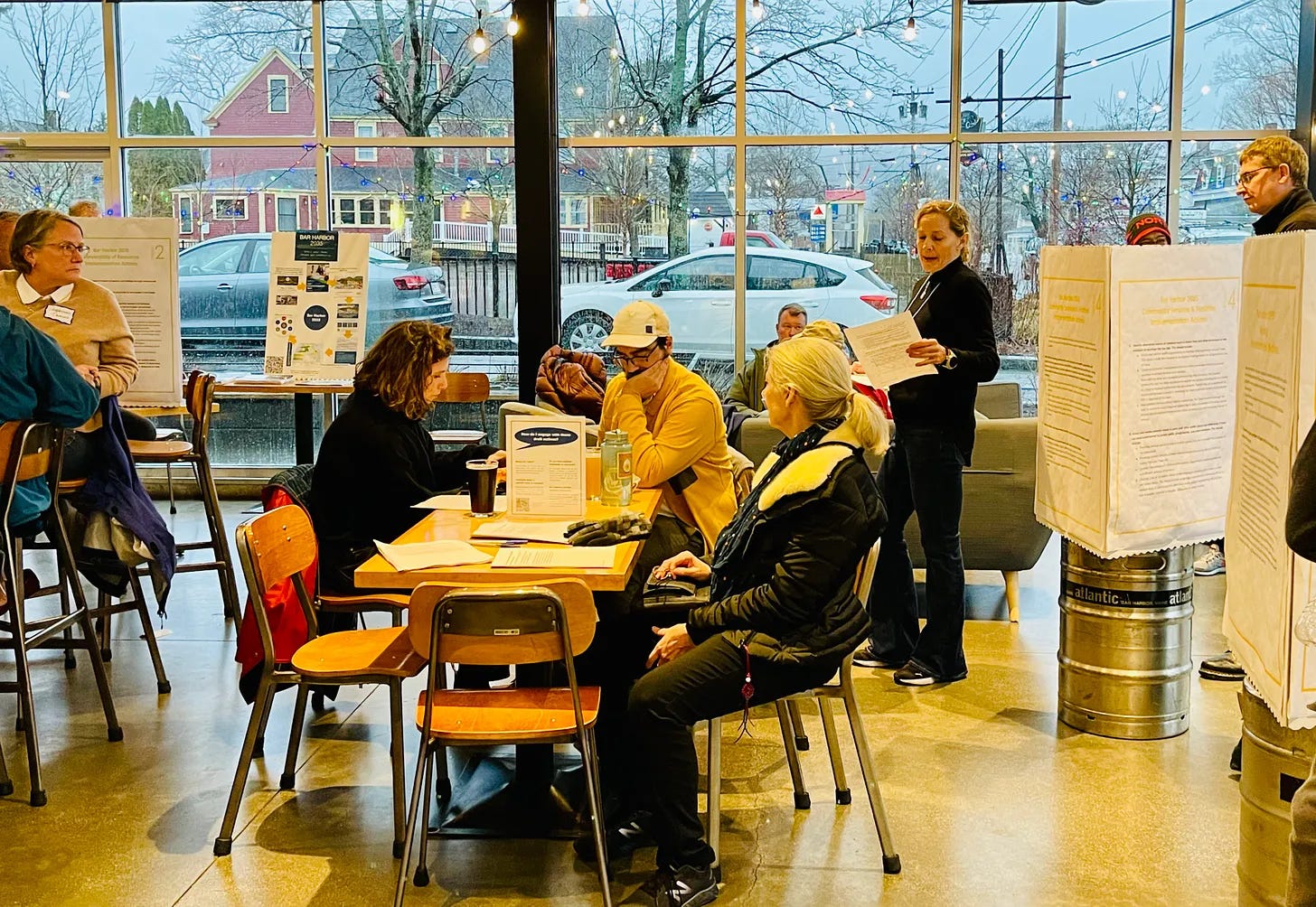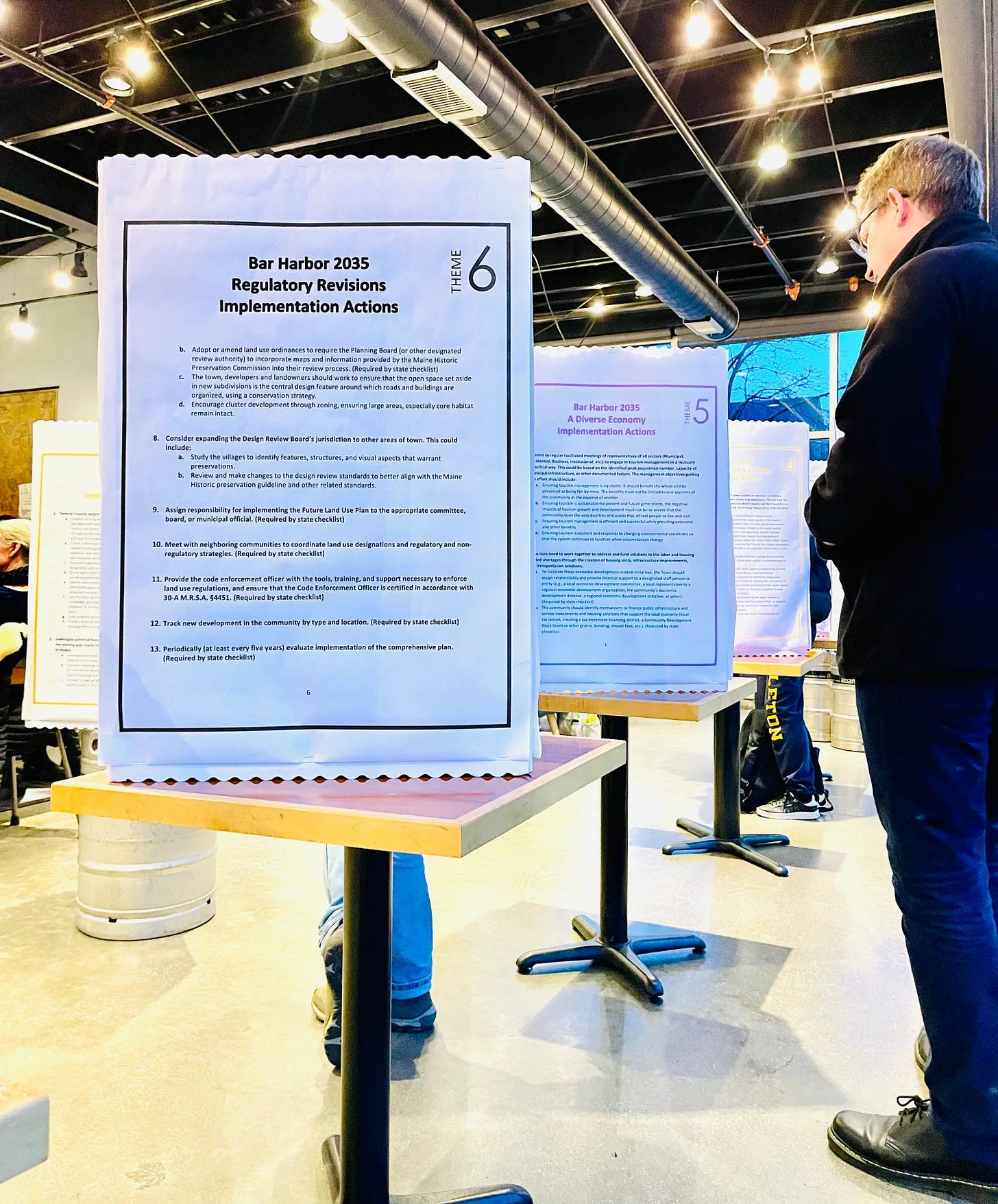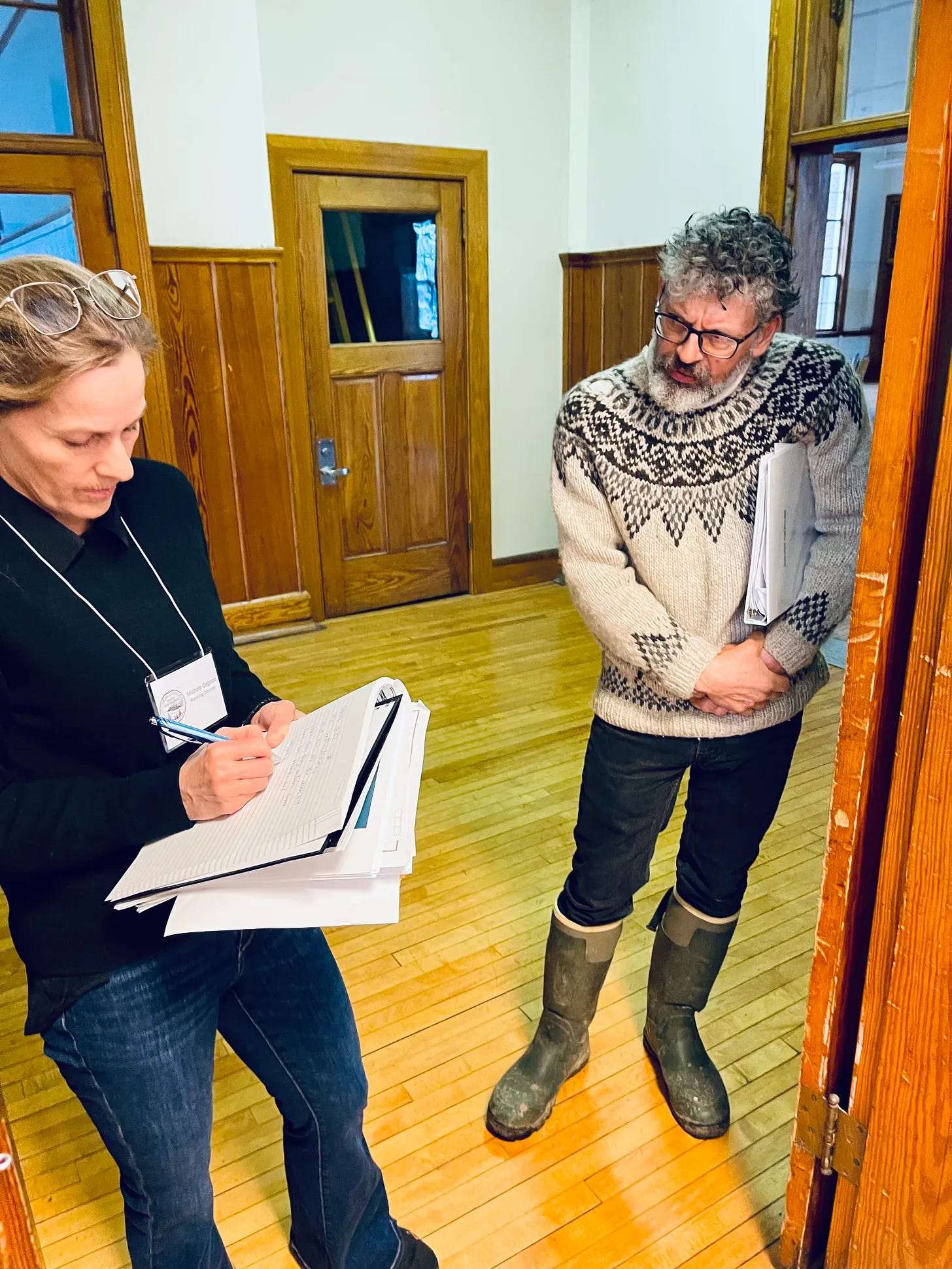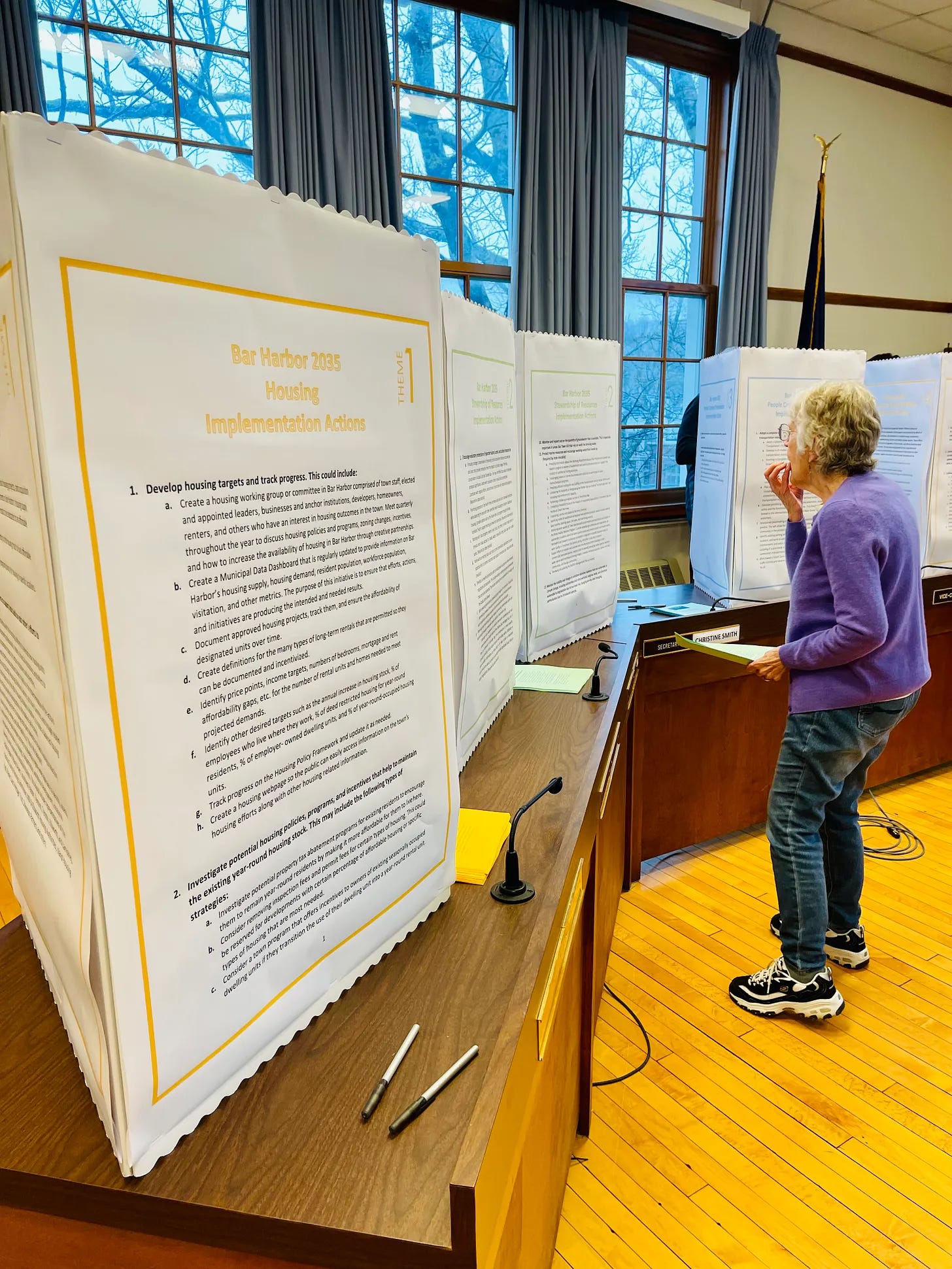The Bar Harbor Story is generously sponsored by Side Street Cafe’s New Year’s Eve Party.
BAR HARBOR—The Bar Harbor Comprehensive Plan is over 100 pages long and years in the making. If you include the data and the other reports that helped to create it? The page count tops over 700 pages.
It’s been state approved, found consistent with the state’s growth-management law, tested and formed in public interaction and engagement and surveys and listening sessions. The state required no changes.
“There was nothing to be changed and that is a very rare occurrence,” Town Planner Michele Gagnon said.
Now, town staff hopes that the town’s proposed comprehensive plan will be approved by voters in June 2025. Comprehensive plans are meant to guide an area’s plan for the future. This plan is intended to look toward 2035.
“I really hope it passes. I hope people are supportive of it,” Gagnon said. “It’s still a plan for the people that I hope they see themselves in it.”
To help people understand the plan, what a comprehensive plan is meant to do, and how it interacts with other town documents and visions and action steps, the Bar Harbor Planning Department presented the draft comprehensive plan to a group of approximately 20 people in person and 10 attending via Zoom on Wednesday night.
Bar Harbor Housing and Community Planner Cali Martinez explained that a comprehensive plan usually lasts 10-20 years, setting the stage for a town’s short-term and long-term actions and goals. Much of the night’s discussion centered around growth areas for more homes such as downtown Bar Harbor and Hulls Cove. Both of those areas are served by the town’s infrastructure (water and sewer). More gentle density is meant to occur in Hadley Point, Salisbury Cove, and Town Hill.
“Downtown creates the greatest opportunities,” Planner Hailey Bondy read from the plan. “It’s really seen as the center of the community.”
”Gentle density for us is defined as focusing on developing for what the land is reasonably able to accommodate,” Bondy said. That includes environmental factors and the character of the area.
During the discussion, both Eddie Damm and Sharon Knopp spoke about growth areas and changes since the 2007 plan. Knopp asked how the plan impacts where and how lodgings can be built.

“This plan goes into the details of areas where we want small scale development or we want gentle density,” Martinez said. It provides guidance of how to change the land use ordinance to align with the visions in the plan. The future land use plan should align with those strategies outlined in the plan.
Stewart Brecher asked if there were any ideas in the document. “It doesn’t seem any different than the old one that didn’t have any ideas in it. There’s no directions. It’s like a teachers’ lesson plan.”
“Maybe it’s not as visionary as you would like,” Gagnon said, “but the vision can also come from where we do deep-dive specific plans for areas.”
Others talked about nitrates in groundwater and the potential elimination of nitrate modeling.
“The plan calls for other methods to make sure that we maintain a healthy environment and healthy drinking water,” Gagnon explained.
Gagnon said that they are looking at build-out analyses for developments. That would deal with a development’s potential ecological impact in an area. There was discussion about sustainable tourism and amenity traps, about key priorities particularly for housing and tourism management, but the plan also, the planners said, gives space for the town to prioritize specific actions. This is a bit unlike the 2007, which had been more minutely detailed.
The town’s prioritization and actions occur via processes such as town council goals, department priorities, seeing what is occurring in the town, and also, they hoped, via yearly reviews of what the town is doing next in relation to the comprehensive plan, including implementation oversight, and understanding the progression of the town in relationship to the plan.
Resilience Planning is the consulting firm for the project. Its contract was extended in December 2022 to allow the committee to gather more public input, data, and to work on the plan for a longer period. That extension also came with an additional $100,000 from the town’s budget.
Comprehensive Plan Committee Members included Elissa Chesler, Jaquie Colburn, Greg Cox, Kevin Desveaux, Cheri Galyean, John Kelly, Jim Mahoney, Calistra Martinez, Michael McKernan, Kristen Murphy, Misha Mytar, Val Peacock, Allison Sasner, Kyle Shank, and David Woodside.
The Bar Harbor 2035 Comprehensive Plan is now available for public review and comment. The plan describes the community's vision for the future and outlines steps to achieve it. Comments are welcome through December and will be considered as the plan is finalized. https://www.barharbormaine.gov//CivicAlerts.aspx?AID=1511
A NOTE FROM US
This is Carrie and Shaun, and as you’ve probably noticed, we’ve been working hard at the Bar Harbor Story, providing local news in a way that keeps you informed, but also embraces and promotes community and the good that is within it.
We take so much time—just the two of us, with a special needs kid that has to be homeschooled—to cover our island community’s (plus, Trenton) local news in a way that’s timely, daily, and remembers that underneath the news . . . there are people who are our neighbors.
We are working hard to get the news out there—for free—for everyone. But it’s taking its toll on our family financially and honestly, sometimes, emotionally, because frontline local news in a small community? It’s hard.
Most media isn’t local (even when it claims it is). Most media has paywalls and advertisers. We don’t. That’s not a smart financial decision for us. It’s a moral one. And we’re going to try to do it for as long as we can because we’re local, we’re passionate, and we’re all about getting the news to everyone—no paywalls.
Richard Stengel, writing in The Atlantic, said, "Paywalls create a two-tiered system: credible, fact-based information for people who are willing to pay for it, and murkier, less-reliable information for everyone else. Simply put, paywalls get in the way of informing the public, which is the mission of journalism.”
As a paper that is owned and staffed by locals, we make every attempt to gather all of the facts for our readers, information that might not be part of the main story and/or information that may not be known even to our towns’ officials, but is still just as important, if not more important, to the story.
We currently have over 3,000 subscribers, the vast majority of them free, with over 230,000 article reads every month. Every one of our stories is opened at least 2,000 times. Most are opened well over that amount.
To continue to provide you with fact based, non-editorialized news, we really need your support! If you’d like to support us or subscribe? It would mean the world to us, and to the Bar Harbor Story!
There are a few ways to do that:
You can send us a one-time support via this link here. It will say “Carrie Jones Books” because that’s what our PayPal account is through.
You can become a paid subscriber at either site here (scroll to bottom) or here (scroll to bottom).
Your business or nonprofit can sponsor the Bar Harbor Story with a banner ad. More information on that is here.
THANK YOU FOR SUPPORTING OUR COMMITMENT TO ALL OF OUR COMMUNITY
LINKS TO LEARN MORE
Bar Harbor 2035 Comprehensive Plan (September 2024) - not including appendices
Implementation Plan (September 2024)
State statute and rules about comprehensive plans
If you’d like to donate to help support us, you can, but no pressure! Just click here.
If you’d like to sponsor the Bar Harbor Story, you can! Learn more here.












